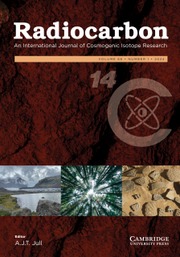Article contents
Testing the Limits: Radiocarbon Dating and the End of the Late Bronze Age
Published online by Cambridge University Press: 18 July 2016
Abstract
Archaeometry is becoming an increasingly important tool in chronological research related to events in the Ancient Near East during the 2nd millennium BCE. This paper is a review of recently published radiometric results in an attempt to establish the probable dating range for one particular event that occurred during the last quarter of that millennium, the end of the Late Bronze Age. The conclusion is that in spite of significant improvements in methodology in recent years, the quantity and quality of radiocarbon data are still insufficient to define the range of that date to much better than a century. It is concluded that the most likely date of the Late Bronze/Iron Age transition (here defined by the arrival of Mycenaean LH IIIC:1b pottery in the Levant) is somewhere in the 8-decade range between ∼1170 to 1100 BCE. A comparative study of archaeological and historical evidence would appear to favor the lower value.
Information
- Type
- Articles
- Information
- Copyright
- Copyright © 2006 by the Arizona Board of Regents on behalf of the University of Arizona
References
- 1
- Cited by

